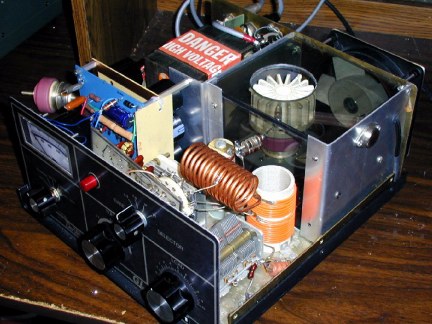DenTron GLA-1000 Amplifier Modification
"A Wolf in Sheep's Clothing"

I have used many different amplifiers over the years. I started out with a Heathkit SB-200 that was very well constructed and performed very nicely. It was a good amplifier to learn with. It was simple, easy to use and forgiving if misused during my learning cycle. These amps are still available today in great quantity. While they are getting somewhat old and their quality depends upon the competence of the original builder, they can still be good amplifiers if you are careful in your search.
I have also owned a National NCL-2000 - a really fantastic amplifier, an Ameritron AL-811H and an AL-80B, a Collins 30L-1, a Henry 2K Classic and a Tokyo Hy-Power HL-1KA.
I discovered during my usage of these different amplifiers that for my needs, about 500 to 700 watts was sufficient. I was bitten by the "legal limit" bug, but I decided that all the problems that go along with operating at that level - RFI, angry neighbors, etc. - were not really worth the hassle. For my casual style of operating, about a half-kilowatt is best.
In this power range I have used the Ameritron AL-811H, the Collins 30L-1 and the Tokyo Hy-Power HL-1KA. All were good performers but I was still having some RFI issues with the four 811A tubes and I thought that the 4CX-250B tubes used in the HL-1KA were overpriced for the power level.
While looking around for an alternative I came across a web site that detailed the conversion of the DenTron GLA-1000 family of amplifiers to use a Russian ceramic tube - the GI7BT. This tube will produce about 600 watts when correctly driven and the old DenTron amps lend themselves readily to conversion to this tube.
OK, before proceeding, a brief note about the original GLA-1000 family of amplifiers. The amplifiers were designed and built in the late 60's and early 70's. They were an attempt to offer a half-kilowatt output at a very reasonable price and at first glance they seemed to do just that. However, there were some design flaws that caused some operational problems. Also, the television manufacturing industry soon moved to solid state design and the cheap sweep tubes that the amplifier used for finals quickly began to disappear. At present, the cost of re-tubing a GLA-1000 with tested and matched NOS tubes would be more than the amp originally cost. For these reasons there are thousands of these amps sitting unused and gathering dust or rusting in some dark attic or garage.
I made inquiries about the GLA-1000 series of amps and was repeatedly told that they were hardly worth the time in original form, but if one was up for the effort, they could be converted into an amplifier that performs solidly and stabily and that perhaps for the first time in their history these machines could truly be "Great Little Amps".
I was lucky enough to get the opportunity to purchase a converted GLA-1000 amplifier done by Ted Lee - N8GPQ - one of the pioneers in this conversion. Ted's work is exemplary and his documentation is complete. He is a consumate ham, always ready to answer questions and help whenever he can.
My amplifier has had the following modifications done:
Conversion to GI-7BT Russian metal/ceramic tube
Addition of bias cutoff circuitry
Modernized power supply components
Tuned input for all bands
10 meter modification
More robust low voltage switching relay
In addition, Ted has designed a PC board that contains ALC circuitry and time delay for tube warmup. I will be adding this board shortly. This amplifier is now a very modern extremely stable 600 watt amplifier that gets superb audio reports. I am very proud of this little amplifier. Visitors to my shack see the DenTron GLA-1000 amp sitting there and I get all kinds of comments - mostly ridicule - until I demonstrate the power of this "Wolf in Sheep's CLothing". More than once I have had offers to purchase the amp afterwards. It is indeed a jewel.
There is extensive information about this conversion and other similar projects on the web, including pictures of my amplifier in the process of being converted. Two great places to begin are KO4NR's site and a conversion tutorial by W4EMF. Note that these two links are to sites outside of this one but they are both tremendous sources of information about this conversion.
If you are comfortable with this level of conversion, give this one a try. The end result will be a superb addition to your operating bench.